Marwari Horse Breed
India is a special fusion of diverse climate zones and landscapes where various equine species play distinct roles. The Marwari horse stands out as the indigenous desert breed of the Marwari region in the state of Rajasthan, India. Known for its ability to travel long distances swiftly, thanks to its robust limbs and hooves, this breed demonstrates remarkable endurance in traversing harsh terrains and extreme weather conditions. The Marwari horse is celebrated for its grace, charm, strength, stamina, cleverness, attentiveness, lively gait, and the distinctive feature of ear tips that elegantly touch each other.
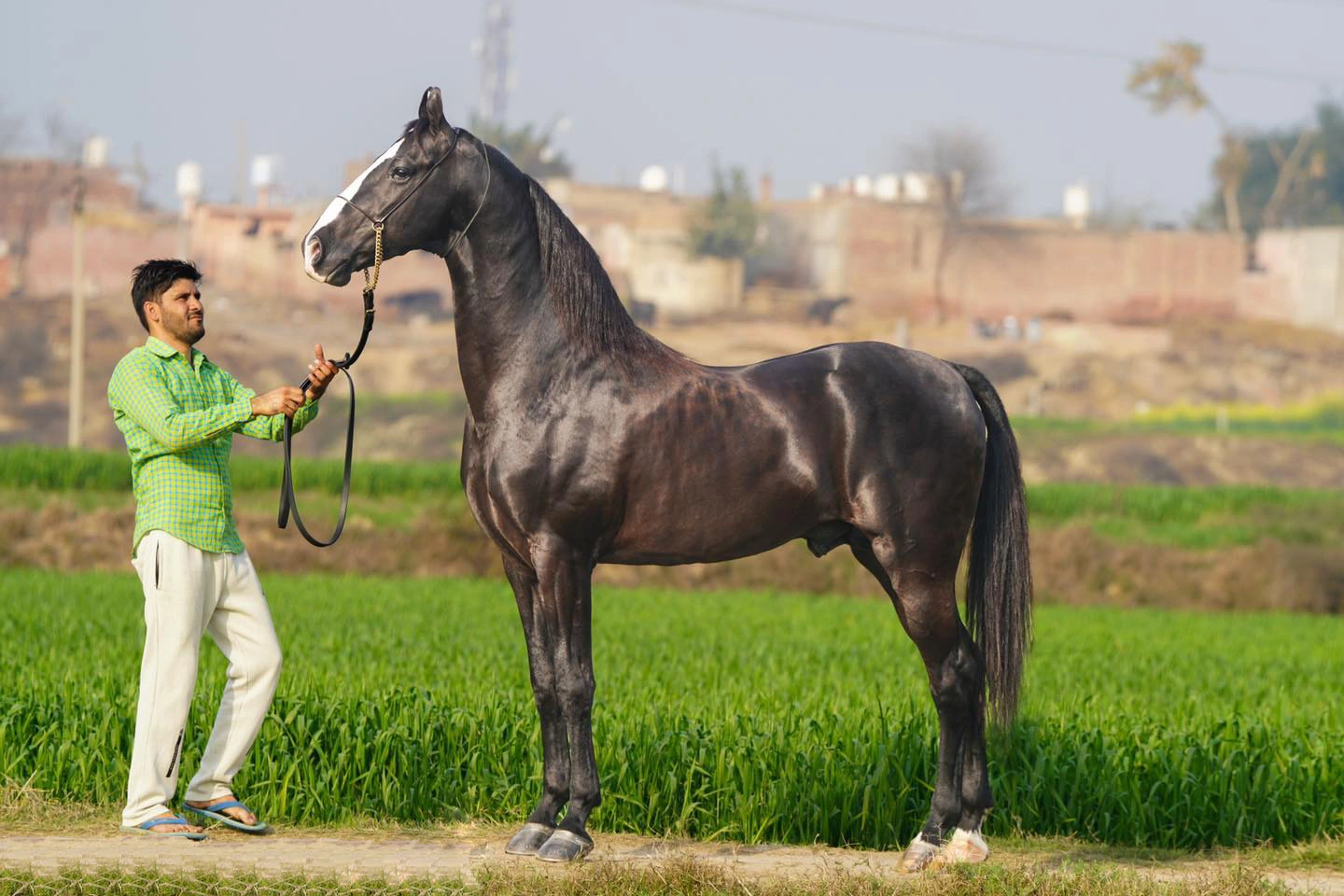
Habitat and Distribution
The Marwari Horses are mainly indigenous to the Malani region of Barmer district in Marwar. They are prominently found in villages such as Nagar, Gurha, Jasol, Sindhari, Patodi, Bakhasar, certain areas of Bhinmal and Sanchore, as well as Sayla Tehsil in the Jalor district. The core of the Marwari Breed of horses lie in these regions where the climate can be quite extreme, ranging between 4ºC to 48ºC.
Currently, these magnificent animals are thriving not only in Rajasthan but also in other states of India. The Marwari horses are primarily bred for exhibitions, Horse Safaris & Sports, ceremonial and religious events, and historically, they were utilized in warfare. Their fame has now extended to states like Punjab and Gujarat.
Population
As per Livestock census (1992) population of horses and ponies of different breeds in the country is approximately 817 million and the population of horses in Rajasthan is approximately 24,000 out of which it was observed that only about 3000 horses are true to Marwari breed and others are cross of Marwari with Kathiawari or Sindhi. The National Research Centre on Equines, Hisar has conducted studies on delineating of breed characteristics of Marwari horses. The breed characters are primarily based on phenotypic/biometrical measurement, genotypic markers, reproductive parameters and molecular markers.
The Head and Forehead
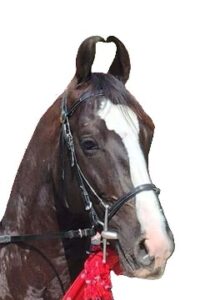
The Marwari horse showcases a well refined head with an average facial length of 56 centimeters. The face is characterized by a width of 21 centimeters. The forehead is sculpted, often having a flat appearance, although some individuals may feature a convex forehead. It sits neatly between the eyes and is complemented by a soft to medium muzzle. Furthermore, the jaws are noticeable and robustly constructed.
The Ears

The moderate- sized ears are velvety in texture, measuring about 13 centimeters from the base to the tip. The standard ear width typically spans around 8 centimeters. Notably, in mares, both the length and width of the ears surpass those of stallions. Furthermore, in horses adhering to their breed standard, the ear tips make contact when the horse rotates its ears to 180 degrees.
The Eyes and Nostrils
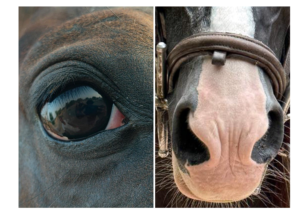
The eyes are sizable, circular, widely spaced, creating a subtle protrusion in the eyeballs. The nasal bridge is elongated and level. The nostrils are expansive, rounded, with a flared appearance, and exhibit heightened sensitivity.
The Shoulders and Neck
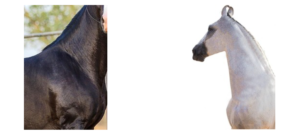
The shoulders exhibit well-developed musculature, elongated and wide, while the neck appears refined at the poll but becomes broader towards the shoulders, with robust musculature at its base. Additionally, the neck is held in a high carriage.
The Back Wither and Height at Withers
The back of the Marwari horse is moderate in size and robust, featuring a deep barrel or girth. Their withers are distinctly well-defined. On average, these horses measure
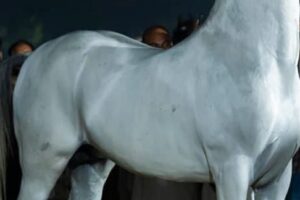
151.80+0.80 cms in height at the withers. Furthermore, the average heart girth tends to be greater in females compared to males (170.48 vs. 168.31, respectively), with an average heart girth of 169.40+1.28 cms in the Marwari breed.
Body Length
The body size of Marwari animals falls within the range of moderate to average. The typical body length measures around 147.04 centimeters, give or take 0.91 centimeters.
Quarters
The living spaces are sturdily constructed and robust, featuring a well rounded and sloppy croup.
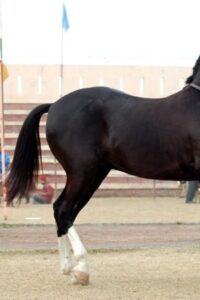
The Legs
The leg length of the horse is considered medium, allowing it to travel long distances at a moderate pace. The average length of the fore leg is 100.03+0.761 cms, while the hind leg measures 100.82+0.555 cms.
Both the front and rear cannon bones are lengthy and positioned perpendicularly. The extensors and flexors exhibit strength and clear definition. The height at the knee typically averages at 46.84+0.29 cms, with a shank circumference of 20 cms.
The fetlock is robust and rounded, while the pastern is short, sturdy, and slopes forward. The front hoof is elongated, whereas the hind hoof is circular in shape. The sole and wall of the hoof are resilient and tough, requiring shoeing only in hilly terrains or on metalled roads.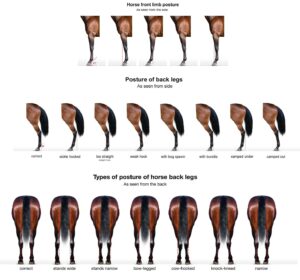
Stifle
Well-developed and spaced apart.
Hock
The hock is wide, sturdy, positioned high, and devoid of excess tissue.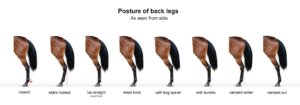
Tail
The Marwari’s tail is correctly positioned and carried high. The average tail measurement is 44.45+025.cms.

Body Weight
The typical weight of a Marwari Stallion is 371.57+ 10.77kg. Males tend to be more massive than females
Colour
Marwari Horses exhibit a diverse array of hues. The prevalent coat colors include Bhanwar (Dark Bay), Kumet (Bay), Telia Kumat (Dark Bay), Kala Ablak (Piebald), Lal Ablak (Skewbald), Surang (Chestnut), Champa (Dun), Sanjab (Blue Roan), Shwet (Grey), and Kagra (Flea-bitten & Dappled Grey).
Nukra (Albino) coloring results in disqualification for this breed.